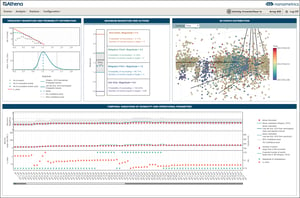
Induced Seismicity Monitoring
Meeting your monitoring mandate, right from the start.
BE REGULATION READY IN HOURS, NOT WEEKS
Induced seismicity is a well-known phenomenon, although events are rarely large enough to be either felt locally or detected by regional seismic networks. Many regulatory bodies have mandated induced seismicity monitoring (ISM) programs that involve the deployment of real-time seismic networks in the vicinity of operations.
Nanometrics’ turnkey monitoring solutions use our proprietary broadband arrays combined with continuous station monitoring, a state-of-the-art data center, industry-leading data processing and cloud applications, including a desktop and mobile app. We manage all aspects of the network design, permitting, installation, commissioning, data acquisition, processing and analysis so you can focus on managing risk and business continuity.
QUESTIONS ABOUT INDUCED SEIMICITY
Induced seismicity is a much-discussed topic, but how to best monitor for induced seismicity often generates more questions than answers:
How many stations are needed to meet the monitoring mandate?
What geographical distribution is needed to meet the monitoring mandate?
Which sensor type one provides the best combination of self-noise, clip level and frequency response to cover the seismic event magnitude and epicenter epicentral distance range?
We provide comprehensive data sets you can trust
Data from public networks does not have the resolution or accuracy required by today’s operators. It’s important to design induced seismicity monitoring networks to provide the richest possible data sets so they can offer benefits beyond basic regulatory compliance. We can provide comprehensive data sets you can trust to drive operational decisions.
The data can and has been used by operators and researchers to assist in identification of geological structures; understanding of the correlation between operational parameters and observed seismicity; investigation of source attributes of induced earthquakes; and derivation of regional attenuation relationships required for accurate magnitude calculations and seismic hazard estimates. The findings can guide operators and regulators in accurately assessing the risks associated with induced seismicity and developing effective risk mitigation strategies.
How effective is your risk mitigation strategy?
A rich seismicity catalogue generated by a properly designed induced seismicity monitoring network can provide some insights into the effectiveness of induced seismicity risk mitigation strategies. A quantitative measure of seismic risk includes assessment of potential hazards and their social, environmental, and economic impacts. Risk mitigation strategies can be applied to both hazard and exposure components. Seismic hazard, referring to the level of ground shaking that may occur at a given probability, can be reduced by minimizing the likelihood of inducing large events.
Manage risk in real time with our turnkey seismic monitoring solutions
We’re on the leading edge of technical innovation and evolving industry demands. We were the first to introduce regional traffic light protocol monitoring in Canada, and we work closely with industry groups and researchers to stay abreast of regulatory discussions and ensure our systems are ready for any potential changes in regulations, including the requirement to monitor ground motions.
Our fully autonomous turnkey monitoring solution uses our proprietary broadband arrays with the latest state-of-the-art event detection, communication and data processing technology.
Athena Data Management Platform
As part of our Seismicity Monitoring Service, you receive access to a secure, customized instance of Athena, our seismic data management platform. This easy-to-use data management, event cataloging and notification tool can be accessed via your mobile device, any time, anywhere.

